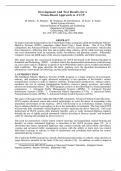Prüfung
Development And Test Results for a Vision-Based Approach to AVCS
- Kurs
- Hochschule
1. INTRODUCTION The Intelligent Vehicle/ Highway Systems (IVHS) program is a major initiative of government, industry, and academia to apply advanced technology to the operation of the Nation’s surface transportation systems in order to improve mobility, transportation productivity, enhance sa...
[ Mehr anzeigen ]



